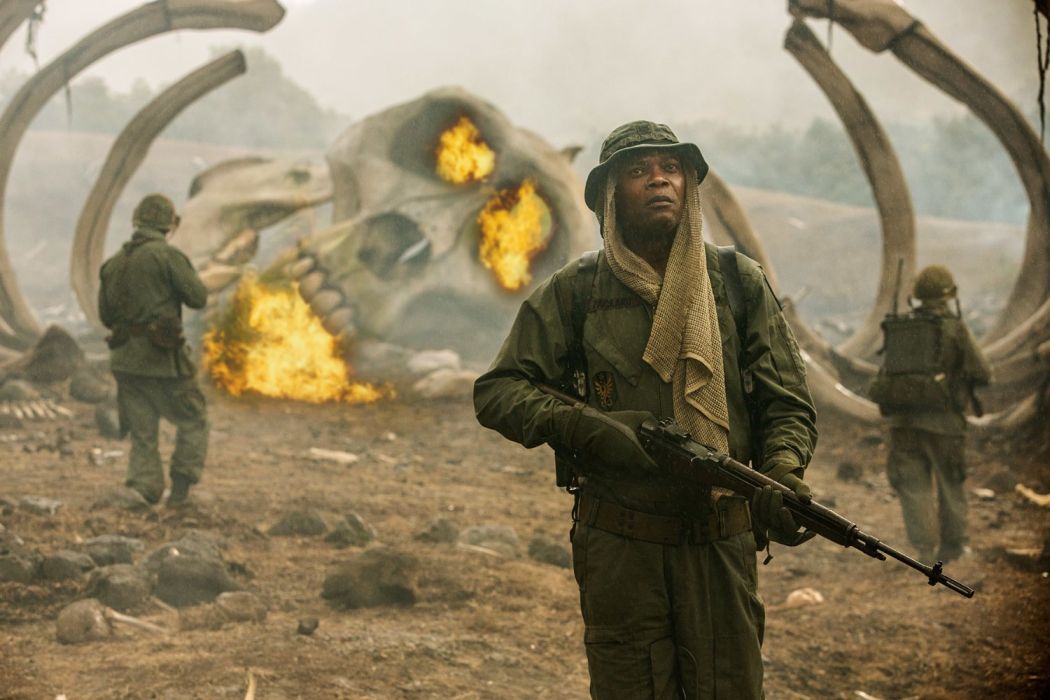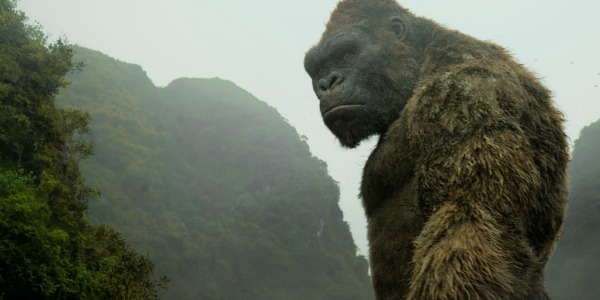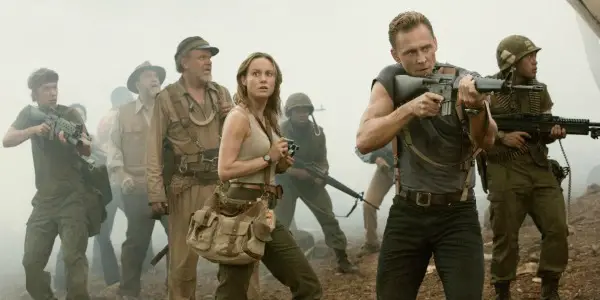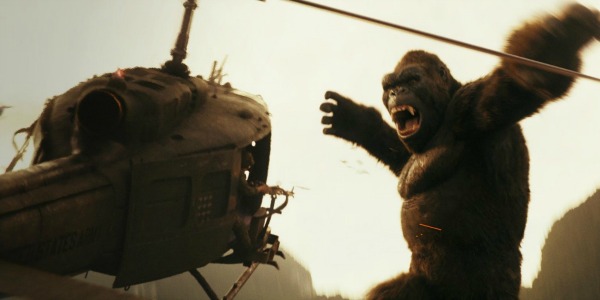KONG: SKULL ISLAND: An Unwieldy Monster Mash

Alex is a film addict, TV aficionado, and book lover.…
The eighth wonder of the world is discovered again in Kong: Skull Island, a reboot that takes great liberties with the traditional Kong plot but never finds its own identity.
Back in 1933, King Kong launched the ape to stardom with its revolutionary special effects and brash score, and subsequent filmmakers haven’t ventured far from that campy, crowd-pleasing debut. Excluding sequels and Toho movies, Kong only reappeared in 1976 and 2005, with both films bearing the same name and key plot points as the original. Skull Island is the first to really strike out on its own, abandoning the damsel in distress premise while keeping the slightly silly and slightly terrifying tone.
If we’re being honest with ourselves, these were never movies where the audience or the filmmaker asked much of each other. They are smash and grab pieces of entertainment, and that in no way lessens their influence or their value. Plenty of people love a good monster movie, and all of these Kong films, Skull Island included, deliver an ape that’s awe-inspiring for its time. However, Kong never would’ve achieved his legendary status without the wonderfully balanced bits of character development and genre-fluent style of the original, and that is where Skull Island fails.
Who Are These People And Their Beast (I’m Still Asking)
One of the biggest changes to this new Kong is his literal size, ballooning the ape to where he and a human barely fit together in a frame. This is allegedly to make him a more formidable opponent for Godzilla in Legendary’s planned MonsterVerse, but for the purposes of Skull Island, it does nothing but set him apart.

Emotional connection to the beast has always been essential to his tragic antihero arc, but this Kong doesn’t exist on the character’s or the audience’s level. He’s elevated to a god-like king, mostly unconcerned with the humans in his domain unless they’re in physical danger. Otherwise, he mopes under the weight of a flimsy backstory, not given any investment in the other character’s fates or they in him. Why, then, should the audience care about Kong at all? This is a serious detriment on its own, but it’s overshadowed by the same question cropping up for every human character as well.
Skull Island is, in general, the kind of film where everyone gets one inadequate personality description that never changes. Brie Larson’s Mason is a tough photojournalist, so she carries a camera and can run screaming with the boys. Samuel L. Jackson’s Preston is a career military man, so he will fight whatever enemy is put in front of him. And in my favorite moment of character ‘development’, we learn that Thomas Mann’s Slivko is the son of a mechanic, so obviously he can fix any jerry-rigged engine he comes across. That’s the definition of a mechanic, right?
Previous Kong films didn’t have complex characters, either, but they did establish some interpersonal relationships (mostly romantic) that allowed the audience to invest in the characters. This version does away with the romance subplot, which is a relatively progressive update to the story, but doesn’t replace its function. What’s left is stock characters getting picked off by unfeeling monsters, and frankly, no one really cares.
When your movie hinges on titillation, on that spine-crawling feeling of seeing a beast overpower man and machine, you need to make the gravity of your monster’s wreckage matter, and nothing matters in Kong: Skull Island.
Themes And Influences With Nowhere To Go
Characters, of course, are not the only reason to care about a film, as the original King Kong displayed with its unabashedly manipulative score. A lot of other elements can pick up the slack, and Skull Island certainly packs in a lot of well-executed style. If points were being handed out solely based on visceral reactions, then I’d be giving this film high marks.
Kong and the other creature’s mayhem are displayed with such glorious variety that their carnage never fails to impress. Problem is, that variety stems from this film’s many half-baked influences and themes, so while you may momentarily revel in an homage to Apocalypse Now, the film never follows through on that tease.

Take, for instance, a line from the film’s clunky first act. “A camera is more dangerous than a gun,” growls Preston to Mason, whose opposing work during the recently concluded Vietnam War makes the line emblematic of American culture at the time. Remember, Vietnam was the first American war in generations that was documented with minimal censorship, and the images that were brought to people’s homes through newspapers, magazines, and television were incredibly influential in ending the war.
That line, then, sets up personal animosity between these two characters and ties into other post-war themes that run through the movie. The weight of this essentially makes her camera into Chekhov’s gun, where the audience expects a payoff. In Skull Island,though, that never comes. In fact, there’s never a clear use for her photos at all, making this portentous line essentially useless.
The whole backdrop of the Vietnam War is used for little more than style points, and it never fully mesh with the film’s other homages and flippant use of comedy. It’s not only tonally jarring, it’s just plain messy. There’s no coherent vision that the production adheres to, making the individual scenes adequately entertaining but the whole an unsatisfying hodgepodge of unresolved ideas.
Those Monsters, Though
Those monsters, indeed! They are the backbone and saving grace of many ill-conceived monster flicks, and Skull Island gets their presentation right.

This Kong is bipedal again, abandoning the more realistic design of Peter Jackson’s 2005 effort for the lumbering brute of old. Unlike those versions, where Kong wasn’t seen until well into the film, Skull Island wastes no time getting to the good stuff. You get a decent teaser in the first five minutes and the lack of character development means the humans line up for slaughter rather quickly. Basically, if you liked the creepy-crawly, blood-filled middle section of Jackson’s film, you’ll be down with this iteration of Kong.
With some gleefully surprising carnage, Skull Island puts enough twists on classic monster rampages to be steadily engaging. This is not the frustrating start and stop of 2014’s Godzilla or a recreation of previous Kong battles but a big-budget CGI battlefield with contenders in every corner. The frequent brawls are convincingly rendered, but the smaller effects look surprisingly poor. It all moves too quickly to care, though, and as the whole mess washes over you, it’s impossible to look away from the amusing mayhem.
Conclusion
Kong: Skull Island is fleeting entertainment, but given its massive budget and the audience’s predisposition to Kong, that’s not a terribly impressive feat. The film toyed with big ideas and fumbled nearly all of them, making it an odd contrast to the deliberate stodginess of 2014’s Godzilla. Considering that the first two entries in Legendary’s MonsterVerse don’t even fail together, how are they supposed to fight together?
What’s your favorite Kong movie? Let us know in the comments!
Kong: Skull Island is currently playing in U.S. and U.K. cinemas. For international release dates, click here.
Does content like this matter to you?
Become a Member and support film journalism. Unlock access to all of Film Inquiry`s great articles. Join a community of like-minded readers who are passionate about cinema - get access to our private members Network, give back to independent filmmakers, and more.
Alex is a film addict, TV aficionado, and book lover. He's perfecting his cat dad energy.













